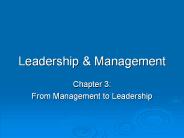Leadership - PowerPoint PPT Presentation
1 / 23
Title:
Leadership
Description:
In order to go anywhere, you need a leader. Then, what is the difference between ' ... 9. Liveliness, and. 10. Athletic ability ... – PowerPoint PPT presentation
Number of Views:148
Avg rating:3.0/5.0
Title: Leadership
1
Leadership
- ELE 41EMT/EIB
George Alexander G.Alexander_at_latrobe.edu.au www.la
trobe.edu.au/eemanage
20 April, 2004
2
In order to go anywhere, you need a leader
Then, what is the difference between Leadership
and Management ?
3
Leadership / Management
- A clear vision and the drive to succeed
- The ability to translate to others
- good communicator
- understands own vision
- Clear principles to guide reactions and decision
for consistency
- Ability to make better decisions and ensure they
are implemented - Systems, structure and skills (processes to
achieve results) - Problem solving (how to)
- Doing it or making sure it is done
4
Leadership / Management
- Peaceful under pressure
- patient
- able to persevere
- A learning disposition
- A self acceptance and understanding, which allows
others to succeed or differ - Try new things
- Planning and control
- Ability to repeat the right solutions (process)
- Good judgement based on analysis
- Able to coach others to develop skills
5
Defining Leadership
- Typically, definitions of leadership satisfy
certain criteria but do no justice to others. - On the other hand, comprehensive definitions tend
to subsume far too many things.
6
Leaders in different fields
- Politics
- Presidents, prime ministers, activists
- Sport
- Team coaches, captains
- Exploration/mountaineering
- Business
- Captains of industry, entrepreneurs
- Entertainment
- Directors, producers
- Military
- Generals, field marshals, - all ranks
- Family
7
Politics (Georges thoughts)
- Franklin D Roosevelt
- Winston Churchill
- John Curtin
- Gough Whitlam?
- Jim Cairns
- Mahatma Ghandi
- Mikhail Gorbachov
- Nelson Mandela, F W de Klerk
- Aung San Suu Kyi
- Student thoughts
- Jeff Kennett
- Hitler highlighting that the wrong vision and
strong leadership are a dangerous mix.
8
Sport (Georges thoughts)
- Joyce Brown
- David Parkin and other AFL
- Steve Waugh and prior cricket captains
9
Business (Georges thoughts)
- Packer
- Murdoch
- Michael Chaney (Wesfarmers/Bunnings)
- Myer family
- Richard Branson
- Other ideas from students
- Donald Trump
- Bill Gates
10
Military (Georges thoughts)
- Eisenhower, Rommel, Montgomery
- Napoleon, Duke of Wellington
- Julius Caesar
- General Monash
11
Common themes
- Vision
- Inspiring
- Inspires confidence
- Recognised ability in field
- Commands trust and respect
- Unshakable determination
- Persuasive
- Enthusiastic
- Leading by example
12
Example Definitions
- Leadership is that quality which enables A to get
B to do what A wants him/her to do - Leadership is that which occurs when A persuades
B that B wants to do what A wants him to do or - Leadership is the process of A and B coming to an
agreement about what needs to be done and then A
arranging the situation so that B can do it.
13
The Common Element
- The crucial element in all of these definitions
seems to be an attempt to persuade other person
to behave in the way in which the leader wishes
him/her to behave. - This element, which is often called leadership
or leadership ability, is seen typically as a
set of special characteristics of an individual.
14
Leadership Types (I II)
- A leaders effectiveness in persuading others is
not only a function of the individual
characteristics but also of situational factors
which might include the rewards at his disposal
(Type I). - The role of an appointed leader, like a
department manager, an armed-forces officer, etc.
(Type II).
15
The Search for Leadership Characteristics
- Early systematic research into leadership was
concerned entirely with those personal qualities
and abilities, which for some reason or the
other, if present in a large quantity or in a
particular combination, were thought to amount
to leadership quality.
16
Continue
Stogdill (1948), reviewing some 124 published
papers on leadership, summarised them in the
following way
(i) The average leader, either elected or
appointed, is above average, compared with the
group members, on the following characteristics
- Intelligence,
- Educational attainments,
- Dependability in exercising responsibilities,
- Activity,
- Social participation,
- Socio-economic status,
- Sociability,
17
Continue
- Initiative,
- Persistence,
- Knowing how to get things done,
- Self-confidence,
- Alertness to and insight into situations,
- Co-operativeness,
- Popularity,
- Adaptability, and
- Verbal facility.
18
Continue
(ii) The characteristics required for a leader
are determined to a large extent by the demands
of the situation.
(iii) Leaders have been found to be above average
on a number of factors specific to well-defined
groups, e.g. athletic ability and physical
prowess in boys gangs and play groups,
intellectual fortitude and integrity for eminent
leaders in maturity.
19
Continue
(iv) In order of decreasing size of average
correlation coefficient, the characteristics
correlating with leadership are
- 1. Originality
- 2. Popularity
- 3. Sociability
- 4. Judgement
- 5. Aggressiveness
- 6. Desire to excel
- 7. Humour
- 8. Co-operativeness
- 9. Liveliness, and
- 10. Athletic ability
20
Continue
(v) The results suggest low positive correlation
between leadership and age, height, weight,
physique, energy, appearance, dominance and mood
control.
(vi) The evidence suggests that leadership
exhibited in various school situations may
persist into college, vocational and community
life.
21
Leadership not only at the top
- Leadership exists at all levels and in all walks
of life. - We should all be aware of what leadership roles
we ourselves should take - At work
- At home
- In the community
22
- And what does this have to do with business
innovation and strategies? - Without leadership, it just wont happen!
23
References
Ribeaux P., Poppleton S.E., Psychology and Work
an introduction, MacMillan Press Ltd, 1978.































